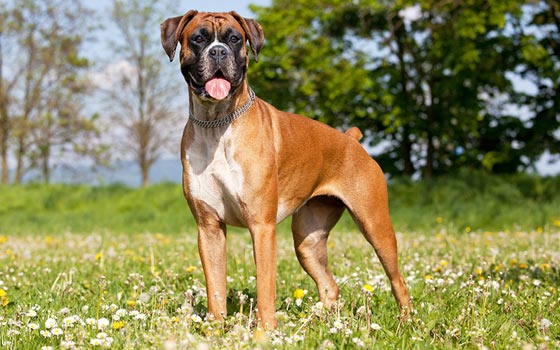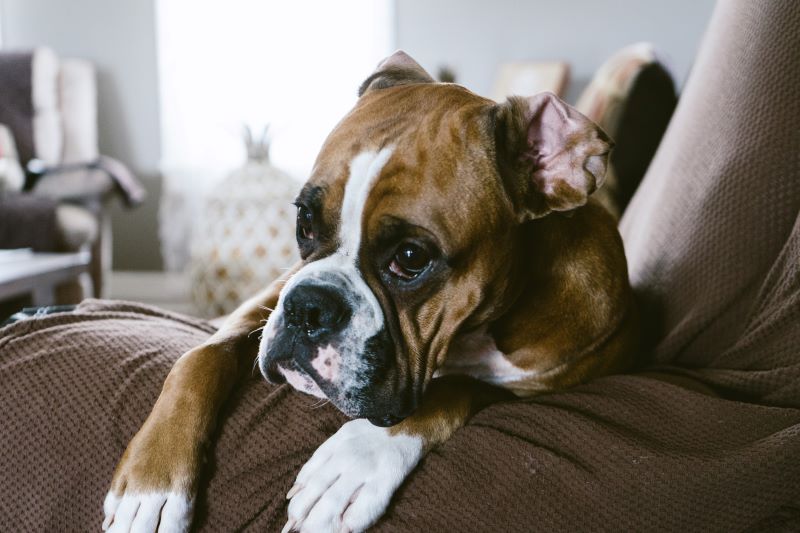Lifespan
08 to 12 years
By : Trupanion Staff | Updated Apr 9, 2024
Lifespan
08 to 12 years
Measuring 20 to 25 inches tall at the shoulder and weighing 55 to 65 pounds
Energy level
Tri-athlete
Breed Group
Working

You’ll always know how a Boxer is feeling! They’re expressive, fun-loving, and silly. But if they feel like their family is in danger, they’re excellent guardians and protectors. Full of energy and seemingly boundless joy, this breed is ready to go-go-go. They were bred as working dogs but make loving companions - quite adept at snuggling on the couch, many think they’re lap dogs. Though their medium size makes this a bit difficult, that doesn’t stop them from trying. As great contortionist, a Boxer will twist their body into a donut or pretzel shape and try their best to fit in your lap so they can be closer to you.
The Boxer breed was developed in Germany toward the end of the 19th century. They’re descendants of the
Bullenbeiser, a breed used for hunting large game. The Boxer’s ancestry can be traced back even further to
the Molossian dogs of 2000 B.C., who were the foundation for many European breeds like the Great Dane,
Mastiffs, Bulldogs, and terriers. Molossians were a strong, large-headed breed used in Assyria for hunting
and as war dogs. They made their way across the European continent over time, particularly during the Roman
conquest. Over time, the Molossian breed evolved into the Bullenbeisser, which became popular in Germany and
Belgium due to their versatility and skill taking down large game.
Before the Napoleonic wars, the Bullenbeisers were primarily kept by nobility who could afford to care for large packs of hunting dogs. But after 1800, these dogs began working for butchers and cattle drivers. Over time, they grew smaller in size and took on the role of family dog and guardian. In 1895, the first Boxer breed club was formed in Munich, Germany. This club created the breed standard and held the first dog show exhibiting the Boxer.
While the American Kennel Club recognized the breed in 1904, it didn’t gain popularity in the States until the mid-20th century. According to the American Boxer Club, Boxers bred in the United States can trace their lineage back to the “Four Horsemen of American Boxerdom,” four male Boxers imported from Germany named Sigurd, Dorian, Utz, and Lustig. One of Dorian’s descendants, named Bang Away, won Best in Show at the Westminster Dog Show in 1951 and the breed’s popularity in the United States took off. As a result, they’ve consistently ranked in the top 10 most popular dog breeds.
While not much has changed in the breed standard since the original was created in 1895, the cropping of Boxers’ ears when they are puppies has fallen out of fashion. The cropped ear is usually only seen in Boxers bred for the show ring, but in 2005 the American show standard began to allow the natural ear. More and more Boxer puppies are also being left with their full tail in Europe and around the world.
Boxers were bred as working dogs and have been used in a variety of roles over their history, from police dogs to therapy dogs. It’s important to provide them with appropriate outlets for their energy and give them the attention they crave. Boxers love being with their people and are known for being both guardian and comforter.
Boxers are a smart breed that might lose interest in training unless it’s varied, fun, and positive (which is better for human learners too!). The breed’s lineage includes mastiffs, bulldogs, and terriers, bred to be hard-working and able to think independently. It’s all about building solid, positive training habits from puppyhood and knowing your Boxer’s motivators.
Boxers do best with consistent positive reinforcement training. Many love working for food (who doesn’t?), but also find toys and play with their human very rewarding.
Training myth vs. fact
Many people describe Boxers as being a “headstrong” and tough-to-train breed, but this just isn’t true! It all comes down to knowing what motivates them and using it to your advantage. They’re descendants of the bulldog and terrier breeds, created specifically to work independently and not give up, so a little hard-headedness is to be expected. With positive reinforcement training methods and consistency, a Boxer is a joy to train and will be an excellent companion. Boxers can also be sensitive to harsh scolding or yelling. Punishments, whether verbal or physical, not only damage the relationship between a Boxer and their owner but also tend not to work in the long run. Often, it creates long-term behavioral issues. By focusing on teaching a Boxer what to do, rather than on unwanted behaviors, they’ll be well-behaved and happy dogs!
Boxers are natural guardians, making them somewhat cautious and reserved when meeting new people. But once you’ve become a friend, they’re much more comfortable showing you their goofy side. Due to their protective nature, proper proactive exposure to new sights, sounds, people, dogs, and other animals as a young puppy is essential for their socialization skills.
Boxers are a frequent breed choice for families with children. They’re playful, protective, and can tolerate the physical handling of young kids when properly socialized. Their medium to large size might be a bit overwhelming for small children, and their exuberant Boxer nature could lead to the occasional knock down. Introducing your Boxer to children as a puppy will help set them up for success. Young children and dogs should always be supervised, and it’s helpful for a dog to have their own “safe space” where they can go when they need some quiet time.
When it comes to animal buddies in the home, it’s once again, all about socialization. Boxers can enjoy and benefit from the companionship of other animals. But be aware, they’re high-energy, rough-and-tumble players that can overpower and scare other dogs. They also have prey instincts that can make it difficult to pair them with cats or smaller animals. Start teaching proper play behaviors while your Boxer is a puppy. And it’s important to always supervise play between a Boxer and other dogs to keep it fun for everyone.
Daily exercise is so important for this bouncy working breed. Boxers need more than just a daily walk. They make good jogging partners. Just be cautious with exercise in warmer temperatures or high humidity, and provide lots of breaks and water. Boxers, like all flat-faced breeds, should always be monitored for heatstroke symptoms, which often include: heavy panting, drooling, bright red tongue or gums, rapid pulse, and wide, panicked eyes.
Speak with your veterinarian about appropriate exercise for a Boxer puppy. Until they are full-grown (bone growth plates typically all close by around 12 to 18 months of age), avoid jogging or running beyond what they would do on their own. This helps minimize risk of damage to the growing bone and cartilage, which can cause pain and future joint issues.
A variety of mental enrichment is essential for a happy and well-behaved Boxer. They are always looking for what to do next. It’s important to keep their focus on acceptable behaviors, otherwise, they might decide digging up your backyard or chewing a hole in your wall is a great idea.
You can work their brains by teaching new tricks, attending obedience classes, joining a dog sport, and providing dog puzzles and interactive toys. Boxers are athletes and love to play fetch — tap into their strengths and sign up for Flyball!

Boxers have a short, smooth, single-layer coat that’s easy to maintain. But this short fur doesn’t provide much insulation, so it’s a good idea to bundle them up with booties and a sweater or jacket when it’s cold. They come in fawn (ranging from red to tan), brindle, or white colors and patterns. White Boxers are more likely to be deaf, as the same piebald gene that causes white coloring is also linked to congenital deafness.
Boxers need weekly brushing, which helps evenly distribute the natural oils in their coat and remove any dirt and shedding fur. Regular bathing is recommended for this breed as well, with special care to keep their face wrinkles clean and dry, which keeps the yeast and bacterial populations in check and prevents uncomfortable and recurrent infections. Introduce your puppy to the grooming experience from a young age to create a positive association and make lifelong grooming easy for everyone.
Best Brush for a Boxer: Bristle brush, rubber curry brush
Punch and Judy were a heroic duo who received Dickin Medal awards for saving British officers during World War II.